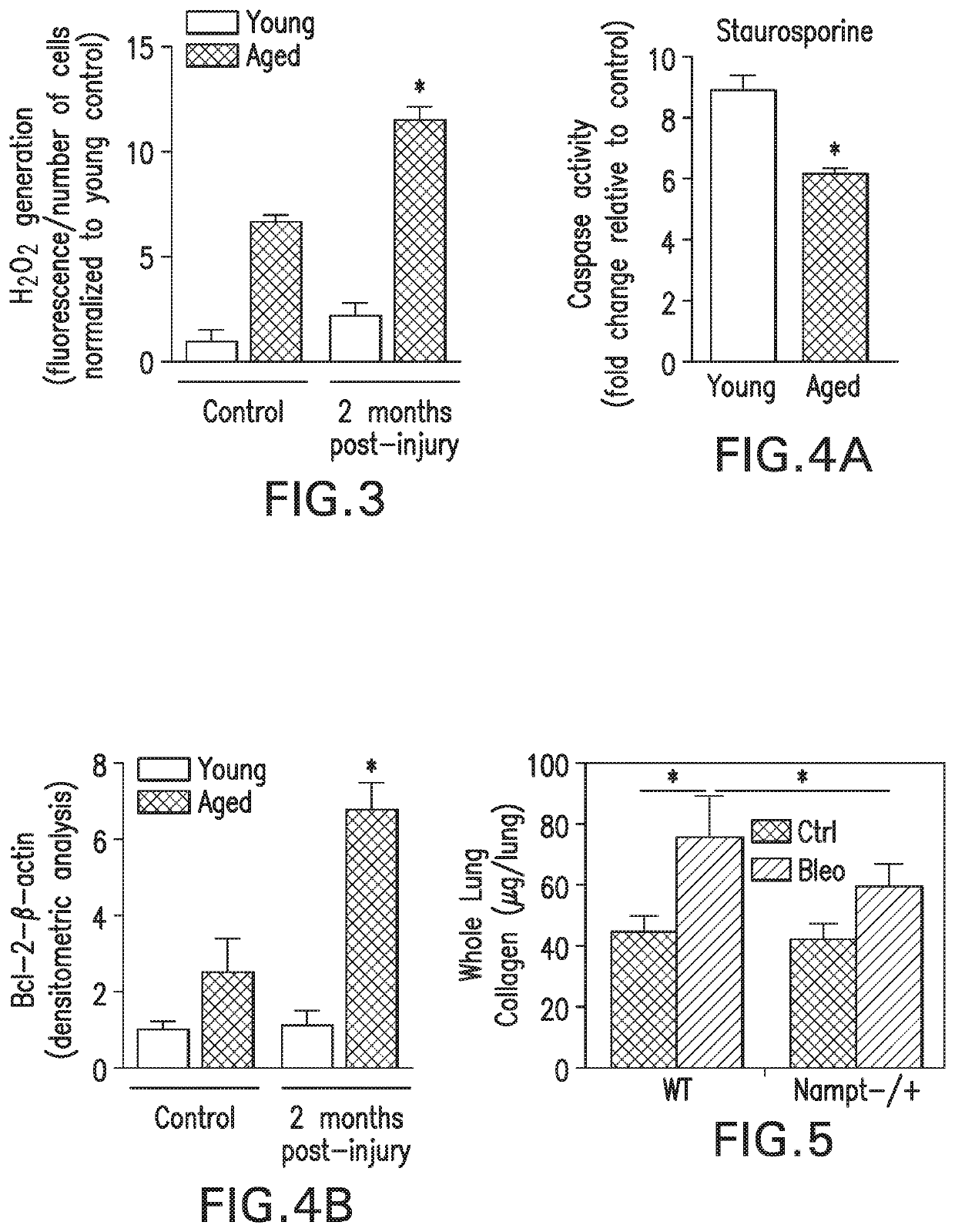Compositions and methods for treating pulmonary fibrosis
a technology of pulmonary fibrosis and compositions, applied in the direction of drug compositions, peptides, immunoglobulins, etc., can solve the problems of increased risk of ipf in patients who have experienced inhalational exposure, significant healthcare burden amongst the aging population, and gas exchange abnormalities and respiratory failure, so as to reduce or prevent one, and reduce or prevent one. the effect of lung inflammation
- Summary
- Abstract
- Description
- Claims
- Application Information
AI Technical Summary
Benefits of technology
Problems solved by technology
Method used
Image
Examples
example 1
Myofibroblasts Demonstrate Senescence & Apoptosis-Resistance
Materials and Methods
[0245]Reagents:
[0246]Porcine platelet-derived TGF-β1 from R&D Systems (Minneapolis, Minn.). Staurosporine from LC Laboratories (Woburn, Mass.). Antibodies to: actin (clone AC-15) and α-tubulin (clone B-5-1-2) from Sigma (St. Louis, Mo.); a-SMA (clone ASM-1) from American Research Products (Belmont, Mass.); cleaved caspase 3, cleaved PARP, and Bcl-2 from Cell Signaling (Boston, Mass.); Nox4 and Ki67 from Novus Biologicals (Littleton, Colo.); and p21, CollA1, and lamin A / C from Santa Cruz Biotechnology (Dallas, Tex.). Antibodies to p16INK4a were from Santa Cruz Biotechnology and BD Biosciences (San Jose, Calif.). Antibodies to GAPDH were from Abcam and Cell Signaling. All other reagents were purchased from Sigma (St. Louis, Mo.), unless otherwise specified.
[0247]Lung Histology and Immunohistochemical Staining:
[0248]Paraffin embedded tissue sections were processed for lung histology and immunohistochemical...
example 2
Show Impaired Resolution of Fibrosis and Accumulation of Senescent Myofibroblasts
Materials and Methods
[0257]Materials and methods are described above.
[0258]Detection of H2O2.
[0259]Extracellular H2O2 release was assayed from cultured cells. Cell number was normalized by DAPI (Fluorescent Cell Count Normalization Kit; MarkerGene Technologies).
Results
[0260]FIG. 1 shows that aged mice demonstrate lack of resolution to bleomycin-induced lung injury compared to young mice. Aged mice exhibited myofibroblast persistence in the fibrotic regions of the lung at 2m post-injury, as determined by immune-histochemical (IHC) staining for aSMA, as compared to young mice with resolving fibrosis. FIG. 2 shows that fibroblasts isolated from young and aged mice demonstrate p16 induction in response to injury that is transient in young mice, while sustained in aged mice with persistent fibrosis. Fibroblasts isolated from injured lungs of aged mice demonstrate higher levels of senescence-associated β-gala...
example 3
ed Senescent Myofibroblasts from Aged Mice Show Resistance to Apoptosis
Materials and Methods
[0262]Materials and methods are described above.
Results
[0263]Consistent with human IPF data, FIGS. 4A and 4B show that lung tissue sections from aged mice post-lung injury show lower levels of apoptosis (TUNEL+cells) in fibrotic regions in comparison to young mice. Fibroblast cells isolated from aged mice demonstrate apoptosis resistance with fewer apoptotic cells with resistance to the apoptosis-inducing agent, staurosporine (FIG. 4A). Consistent with the acquisition of an anti-apoptotic phenotype, lungs from aged mice demonstrate elevated levels of Bcl-2 (FIG. 4B).
[0264]Taken together, these results demonstrate that non-resolving fibrosis in aging is associated with acquisition of a senescent and apoptosis-resistant myofibroblast phenotype.
PUM
| Property | Measurement | Unit |
|---|---|---|
| Time | aaaaa | aaaaa |
| Mass | aaaaa | aaaaa |
| Mass | aaaaa | aaaaa |
Abstract
Description
Claims
Application Information
 Login to View More
Login to View More - R&D Engineer
- R&D Manager
- IP Professional
- Industry Leading Data Capabilities
- Powerful AI technology
- Patent DNA Extraction
Browse by: Latest US Patents, China's latest patents, Technical Efficacy Thesaurus, Application Domain, Technology Topic, Popular Technical Reports.
© 2024 PatSnap. All rights reserved.Legal|Privacy policy|Modern Slavery Act Transparency Statement|Sitemap|About US| Contact US: help@patsnap.com










